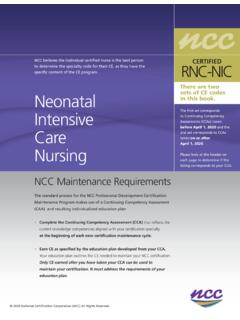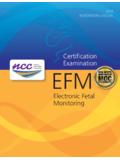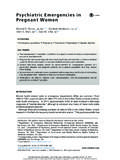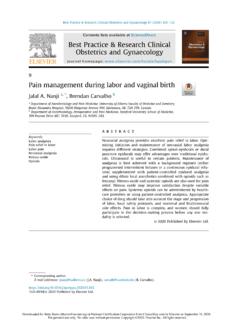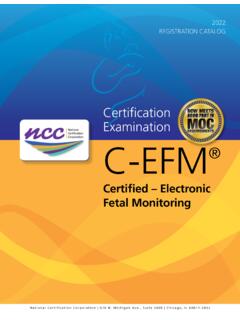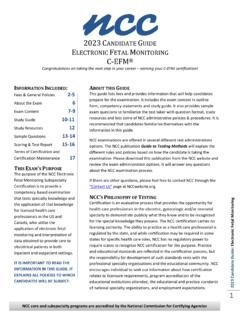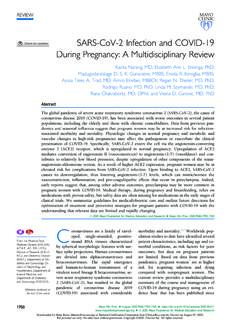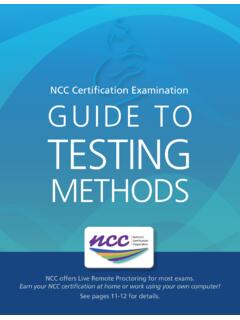Transcription of The Neurobiological Impact of Postpartum …
1 The NeurobiologicalImpact of PostpartumMaternal DepressionPrevention and Intervention ,MD,PhDa,*,LauraScaramella,PhDb, ,MDaINTRODUCTIONPPD represents a significant public health problem with prevalence estimates rangingfrom 12% to 19% and clear negative implications for both maternal and infant healthand 3 Although risk factors for PPD are generally similar to those fordepression at other time points in the life course, the substantial neuroendocrinechanges that occur in a mother immediately after birth and the significant increasein contextual stressors that accompany caring for an infant may compound theseDisclosures: The authors report no commercial or financial of Psychiatry and Behavioral Sciences, Tulane University, 1430 Tulane avenue,#8055, New Orleans, LA 70112, USA;bDepartment of Psychology, The University of NewOrleans, 2000 Lakeshore Drive, New Orleans, LA 70148, USA* Corresponding author.
2 Department of Psychiatry and Behavioral Sciences, Tulane University,1430 Tulane Avenue, #8055, New Orleans, LA Postpartum depression Psychotherapy Dyadic interventions Neurobiology Early life stress InfantsKEY POINTS Postpartum depression (PPD) is a highly prevalent public health concern with implicationsfor infant Neurobiological outcomes. To date, evidence for universal and selected interventions is limited in terms of efficacy forthe treatment of PPD, and there is a dearth of evidence for the Impact of any interventionon infant neurodevelopmental outcomes. A small but growing body of research suggests that indicated psychotherapeutic interven-tions have positive effects on infant Neurobiological outcomes. Greater incorporation of biological outcomes in both infants and mothers is needed toimprove long-term infant and maternal outcomes in women at risk for Adolesc Psychiatric Clin N Am 25 (2016) 179 200 $ see front matter 2016 Elsevier Inc.
3 All rights from at National Certification Corporation November 01, personal use only. No other uses without permission. Copyright 2016. Elsevier Inc. All rights 6 For instance, using data from the National Epidemiologic Survey on Alcoholand Related Conditions, Le Strat and colleagues7compared characteristics ofwomen currently or within the past year pregnant with and without , depressed women were more likely to be unmarried, multipara,and ethnic minority status. Compared with nondepressed women, depressedmothers also were more likely to be under the age of 25, have lower income levels,and be less educated. Depressed mothers were significantly more likely to use illicitsubstances and were 8 times more likely to also suffer from other psychiatric disor-ders than nondepressed women or nondepressed , risk forPPD has been linked to increased exposure to stressful life , like teenage parenthood9or military involvement (eg, military wives),10have also been associated with elevated PPD.
4 Exposure to both early life adversityas well as current life stressors, such as unemployment, change in marital status,death of a loved one, and disease, seems to increase risk for PPD, particularly amongwomen with presumed genetic vulnerability and with limited access to protective re-sources (eg, social support and financial support).11 Unfortunately, these same riskfactors may affect maternal caregiving, potentially resulting in a synergistic negativeeffect on infant Neurobiological the significant number of maternal -infant dyads affected by PPD, there is agrowing interest in developing better population-wide and demographically focusedefforts to increase PPD identification and implement effective treatment. Public healthapproaches to preventive interventions distinguish among universal, selective, andindicated interventions include health promotion effortsand intervention efforts aimed at a broad population.
5 Public service messagesaddressing PPD, for example, might help women recognize how PPD differs frommore typical symptoms of exhaustion, sleep disruption, and emotional lability thatare prevalent in the weeks after delivery of a child. Selective interventions target mem-bers of a group who have high lifetime or high imminent risk for depression . Someestimates indicate that almost 40% of women with children under the age of 3 yearsold and who live in stressful urban environments, for example, have elevated levels ofdepressive intervention to prevent depression that targets impover-ished, inner-city mothers after the birth of a child is a selective intervention. Finally,indicated preventions target those who manifest depressive symptoms that may laterbecome a full-blown disorder.
6 Referral of women who screen positive on theEdinburgh Postnatal depression Scale,14or a similar measure, at the 6-week post-partum check-up in a perinatal intervention program is an indicated for pediatric health care providers, including mental health, the publichealth relevance of PPD extends beyond mothers to include the effects of both theillness itself and intervention efforts on their infants. With this in mind, preventive inter-ventions can also be evaluated in their ability to buffer the Impact of maternal depres-sion on her offspring. Despite the clear links between maternal PPD and negative childoutcomes, the Impact of current efforts targeting the prevention and/or treatment ofPPD to also diminish the negative Impact on child outcomes remains limited.
7 In olderchildren, evidence of the positive effects of treatment of parental depression for bothchildren and parents has been reported, although for the most part this has beenlimited to examination of the effects on child psychopathology without explorationof other health and biological ,16 For young children, where maternaldepression is more likely to substantially influence caregiving and the dyadic relation-ship, the few existing studies that have explored the direct Impact of PPD interventionson infant short-term and long-term outcomes suggest that current approaches areinsufficient to protect or buffer offspring from the harmful effects of et al180 Downloaded from at National Certification Corporation November 01, personal use only.
8 No other uses without permission. Copyright 2016. Elsevier Inc. All rights review focuses on infant neurodevelopmental outcomes associated specif-ically with PPD and its treatment. The neurodevelopmental and health effects of medi-cation use, specifically selective serotonin reuptake inhibitors, on prenatally exposedinfants remain a highly prolific area of research covered in depth elsewhere and arebeyond the scope of this review (for reviews, see 20). In examining the impactof interventions on Neurobiological outcomes in offspring, the authors propose that afocus consistent with the Research Domain Criteria21on neural systems and biologicalpathways, as opposed to diagnostic categories, provides greater insight into needednext research steps.
9 Despite established links between PPD and myriad negativehealth outcomes across the life course, the mechanisms and specific pathwaysthrough which this elevated risk is embedded remain poorly defined. Disentanglingmechanisms and moderators that include shared and independent genetic liability;familial environment, such as social support, paternal factors, and parental discord;infant temperament; and other factors is a needed, albeit complex, next step with sig-nificant public health and policy implications. Delineating the modifiable factors, as-pects of preexisting risk, and specific treatment components associated withimproved child outcomes, is expected to enhance the efficacy of PPD interventions,not only for reducing maternal symptoms but also for promoting infant health anddevelopment.
10 Given the challenge, particularly in young children, of eliciting dataabout psychological symptoms from sources other than caregivers, and the potentialimpact of depression symptoms on parent report of child behavior, establishing bio-markers of both vulnerability and resilience in infants exposed to maternal PPD is crit-ical. The pressing need for these advances is further highlighted by the existingliterature, albeit limited, suggesting that treatment of maternal depression does notnecessarily result in improved maternal -child interactions, one of the key proposedmechanisms through which PPD has a negative Impact on infant NeurodevelopmentThe intricate development of the human brain begins only a few short weeks afterconception and continues for decades.
